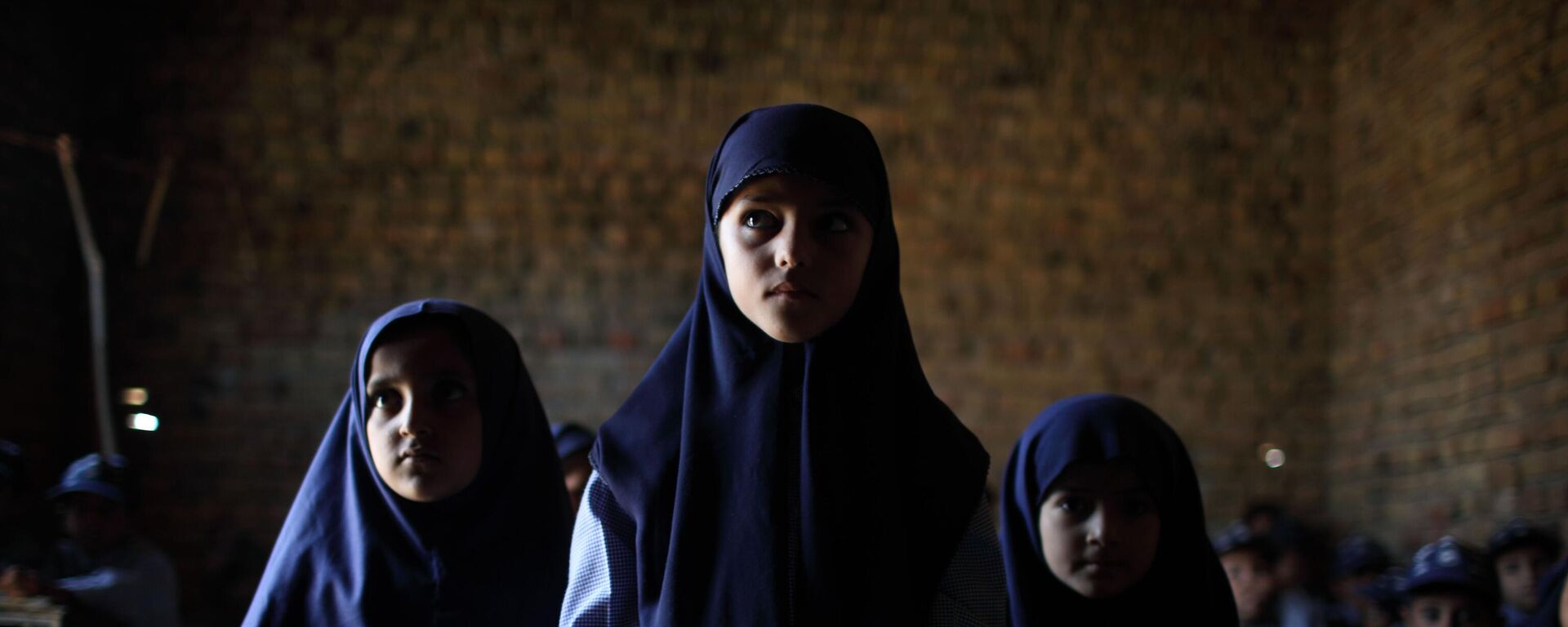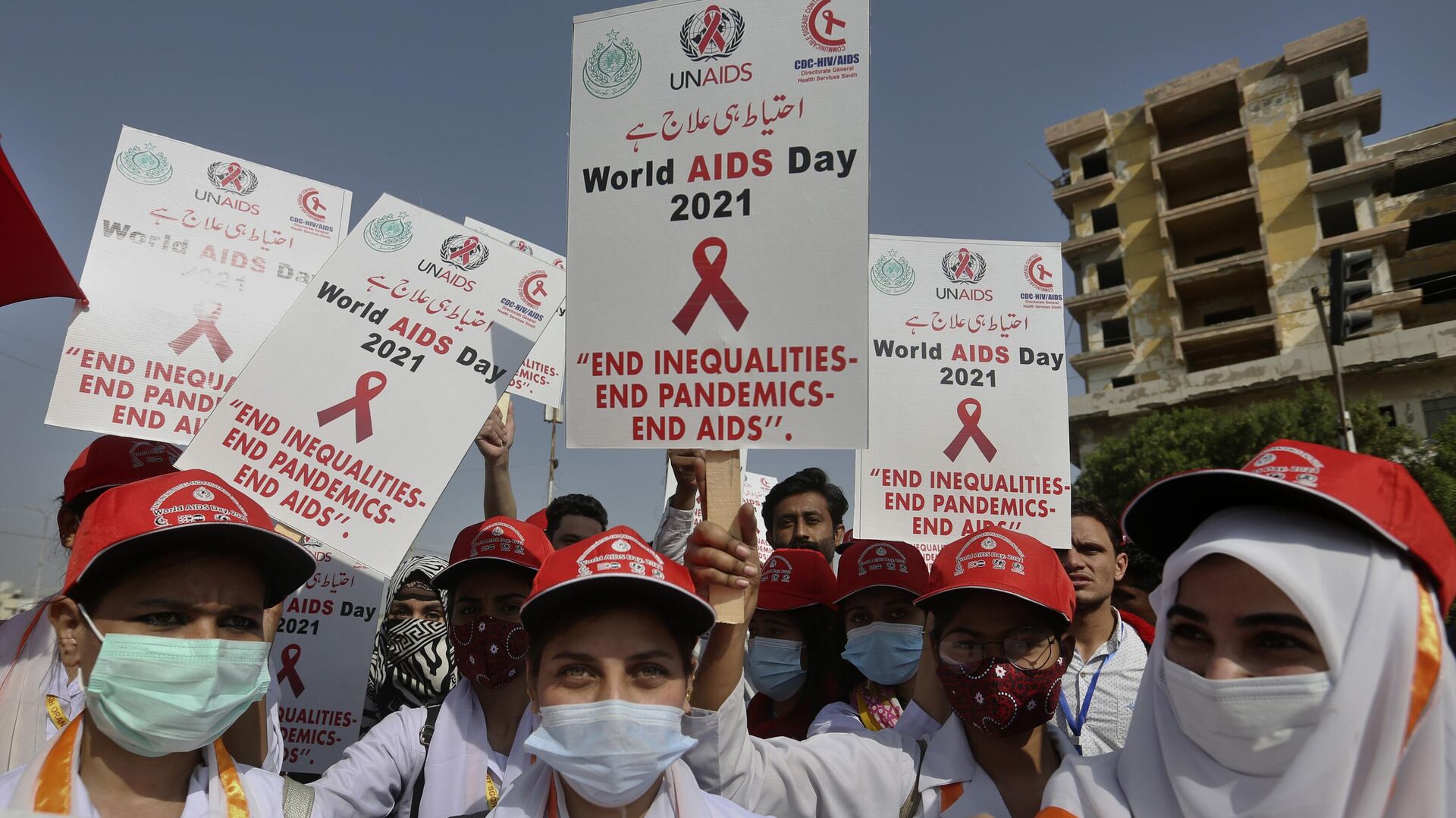https://sputnikglobe.com/20221212/eliminating-the-stigma-is-there-hope-for-hiv-positives-in-pakistan-1105361382.html
Eliminating the Stigma: Is There Hope for HIV Positives in Pakistan?
Eliminating the Stigma: Is There Hope for HIV Positives in Pakistan?
Sputnik International
There is an alarming spread of the HIV in Pakistan, with the number of infections rising each year. According to official data, almost 10,000 people have been... 12.12.2022, Sputnik International
2022-12-12T12:10+0000
2022-12-12T12:10+0000
2022-12-12T12:10+0000
world
pakistan
hiv/aids
epidemic
health
virus
socio-economic
outbreak
society
disease
https://cdn1.img.sputnikglobe.com/img/07e6/0c/0b/1105362350_0:0:3093:1739_1920x0_80_0_0_06166802fd24f024fbdf9255f3ac7004.jpg
According to National Health Services Regulations and Coordination, every month some 1,000 new HIV cases are being reported from all four provinces (Punjab, Sindh, N.W.F.P and Balochistan), capital Islamabad, region of Azad Kashmir and Gilgit Baltistan.Overall as of 2022, Pakistan has an estimated 165, 000 HIV-positive people. South Asia’s second-largest country is only a few steps behind India and Nepal in terms of the HIV infection rate.UNAIDS reported that the HIV prevails in key populations such as, "People who inject drugs (PWID), male, female and transgender sex workers (MSW, FSW & TGSW), men who have sex with men (MSM) and transgenders."This month on World AIDS Day (December 1), Pakistan's Prime Minister Shehbaz Sharif urged the health ministry to focus on awareness about testing, prevention and treatment of the virus.Human Immunodeficiency Virus (HIV)HIV (human immunodeficiency virus) is a virus that damages the cells of the immune system and weakens the body's ability to fight everyday infections and disease. If left untreated, HIV can lead to a potentially life-threatening disease called AIDS (acquired immunodeficiency syndrome).There is currently no effective cure for AIDS or HIV and if a person gets infected with the virus, they have it for life. However, with proper medical care, HIV can be controlled and people can live long and relatively healthy lives.According to a number of scientific journals, the HIV infection in humans came from a type of chimpanzee in Central Africa. Some studies show that the HIV may have jumped from chimpanzees to humans in the late 1800s.The chimpanzee version of the virus is called Simian Immunodeficiency virus. It was probably passed to humans when they hunted these animals for meat and came in contact with their infected blood.Over the next few decades, the HIV slowly spread across Africa and later into other parts of the world. As a result, there are approximately 38.4 million people across the globe living with the HIV today.When a person gets infected with the virus, they are likely to develop symptoms within 2 to 4 weeks after infection. Symptoms may last for a few days or several weeks and include: fever, night sweats, body aches, mouth ulcers, rash, fatigue, swollen lymph nodes and sore throat.However, in some cases people develop no symptoms at all for years, hence, the only sure way to know if someone has contracted the HIV is to get tested. A blood sample given in a clinic can determine the result within a few days.Following the early symptoms people can then quickly develop health complications that lead to AIDS. People with AIDS, also known as stage-3 HIV, have badly damaged immune systems and can get an increasing number of other infections or serious illnesses, because their body loses the ability to fight diseases.Without the HIV treatment, people with AIDS typically survive about three years.Outline of HIV Outbreaks in PakistanIn 2019, in a town of Ratodero, in Pakistan's southern province of Sindh there was a mass outbreak of HIV cases in children. More than 1,500 children contracted the HIV under mysterious circumstances.The case drew attention of local and foreign specialists, and upon investigation it was discovered that a doctor in a local children's hospital was reusing syringes.Authorities blamed a single pediatrician Ratodero for causing the outbreak. Dr Muzaffar Ghanghro, who is now believed to be out on bail, denied the charges, saying other doctors have accused him of being behind the outbreak because of his successful practice. Fifty-two children infected by the HIV in Ratodero have since died.In a similar case, a "doctor" in Larkana was infecting people with the HIV using dirty syringes in his clinic without knowing what the HIV was or how it spread. Upon investigation it was revealed that he himself was infected with the HIV, but had no idea because he had no symptoms.Hurdles Along the Health PathSpecial Assistant on National Health Services Dr Faisal Sultan spoke about what he described as “fundamental flaws” in the healthcare system whether it was Jalalpur Jattan in Gujrat where an HIV outbreak occurred over a decade ago or the 2019 Ratodero outbreak.However, this national cohesion against the HIV is yet to be seen in Pakistan. There is an extremely low HIV screening and treatment coverage in the country despite the rising number of new cases. The use of unsterilized medical tools, unsafe blood transfusions and use of contaminated multiple blades by clinics and hospitals is one of the biggest causes of the HIV infections. Lack of education and awareness about the HIV among the masses is another reason for the spread of the virus. Furthermore, there is also a stigma attached to the disease, and many people who suspect having the HIV avoid going to the hospitals to get tested.According to Dr Baseer Achakzai, the manager of the National Aids Control Program (NACP), "The reasons for new infections, include the lack of political will, bureaucratic hurdles, the stigma attached to the disease, the absence of treatment and technical facilities and trust deficiency [between implementing stakeholders]."Social Factors Behind the Rise in InfectionsOther factors have also contributed to the rise in HIV in the country, including an active population of sex workers, especially male-to-male sex workers, and injecting drug users.Pakistan is going through another social issue as the transgender community faces joblessness and they get used as sex workers. Reportedly, transgenders are contributing 7.6% of AIDS infected patients. According to an estimate, there are 60,000-70,000 people from transgender community who are infected with the virus.According to a report by Senator Rehman Malik, homosexuals contribute to 5.2% of the total population of Pakistan and are another major cause of spreading AIDS across the country.The port city of Karachi was identified as one of the top cities globally with a rise in HIV prevalence and despite that there is still reluctance of government officials to document exact numbers of infected people and bring to light the contributing factors that cause the rise of HIV.Furthermore in the capital city of Islamabad, the number of young men having HIV is also growing exponentially. Just last month, new reports shocked the nation when it was revealed that every day 3-4 young men from affluent and educated families report having contracted HIV.In July, 53 new HIV patients were registered with Islamabad's PIMS treatment center, 61 tested positive for HIV in August, while 64 in September and 49 new people tested positive in the month of October 2022.According to Dr. Nailana Bashir, in charge of the HIV treatment center at PIMS Islamabad, "Most of them who are being tested positive for the last couple of years are young, educated men who practice same sex. Most of them know their practice so they search about risks involved with their sexual behavior and get themselves tested for HIV."She further said that young men and boys who tested positive for the HIV need psychological aid because as soon as they learn about their HIV status, many of them have suicidal thoughts and some of them even try to commit suicide.The best treatment for the HIV is Antiretroviral therapy (ART). It involves taking a daily combination of HIV medications (known as an HIV treatment regimen). It is available in Pakistan, and at some government centers it is reportedly available for free in an attempt to control the spread of the virus. Hence, anyone who has unfortunately contracted HIV, needs to know that it is no longer a death sentence.Globally, antiretroviral therapy is recommended for everyone with HIV and although ART cannot cure the person completely, it can help patients with the virus live longer and healthier lives.The views and opinions expressed in this column are those of the author and do not necessarily reflectthe position of Sputnik.
https://sputnikglobe.com/20221201/how-africa-making-progress-in-eliminating-hivaids-despite-poverty-inequality--fraudsters-1104943074.html
https://sputnikglobe.com/20221019/magic-amulets--horse-steroids-fake-doctors-wreak-havoc-on-patients-in-pakistan-1102079246.html
https://sputnikglobe.com/20221207/exponential-growth-of-madrasas-in-pakistan-conservative-education-or-hateful-indoctrination-1105151992.html
pakistan
Sputnik International
feedback@sputniknews.com
+74956456601
MIA „Rosiya Segodnya“
2022
Aneela Rashid
https://cdn1.img.sputnikglobe.com/img/07e6/09/0e/1100768477_0:338:606:944_100x100_80_0_0_af078d1bbaf1e33c21f16169e9ed7a5f.jpg
Aneela Rashid
https://cdn1.img.sputnikglobe.com/img/07e6/09/0e/1100768477_0:338:606:944_100x100_80_0_0_af078d1bbaf1e33c21f16169e9ed7a5f.jpg
News
en_EN
Sputnik International
feedback@sputniknews.com
+74956456601
MIA „Rosiya Segodnya“
Sputnik International
feedback@sputniknews.com
+74956456601
MIA „Rosiya Segodnya“
Aneela Rashid
https://cdn1.img.sputnikglobe.com/img/07e6/09/0e/1100768477_0:338:606:944_100x100_80_0_0_af078d1bbaf1e33c21f16169e9ed7a5f.jpg
pakistan, hiv/aids, epidemic, health, virus, socio-economic, outbreak, society, disease, treatment, medicine
pakistan, hiv/aids, epidemic, health, virus, socio-economic, outbreak, society, disease, treatment, medicine
Eliminating the Stigma: Is There Hope for HIV Positives in Pakistan?
There is an alarming spread of the HIV in Pakistan, with the number of infections rising each year. According to official data, almost 10,000 people have been tested positive for HIV in the past ten months. What is behind the rise in infections and is there hope for those who have contracted the disease?
According to National Health Services Regulations and Coordination, every month some 1,000 new HIV cases are being reported from all four provinces (Punjab, Sindh, N.W.F.P and Balochistan), capital Islamabad, region of Azad Kashmir and Gilgit Baltistan.
Overall as of 2022, Pakistan has an estimated 165, 000 HIV-positive people. South Asia’s second-largest country is only a few steps behind India and Nepal in terms of the HIV infection rate.
UNAIDS reported that the HIV prevails in key populations such as, "People who inject drugs (PWID), male, female and transgender sex workers (MSW, FSW & TGSW), men who have sex with men (MSM) and transgenders."
This month on World AIDS Day (December 1), Pakistan's Prime Minister Shehbaz Sharif urged the health ministry to focus on awareness about testing, prevention and treatment of the virus.
"The increasing incidence of HIV & Aids among children and adolescents is deeply worrying," PM Shehbaz Sharif said in a tweet. He encouraged everyone to "vow to end the stigma attached to HIV."
Human Immunodeficiency Virus (HIV)
HIV (human immunodeficiency virus) is a virus that damages the cells of the immune system and weakens the body's ability to fight everyday infections and disease. If left untreated, HIV can lead to a potentially life-threatening disease called AIDS (acquired immunodeficiency syndrome).

1 December 2022, 16:09 GMT
There is currently no effective cure for AIDS or HIV and if a person gets infected with the virus, they have it for life. However, with proper medical care, HIV can be controlled and people can live long and relatively healthy lives.
According to a number of scientific journals, the HIV infection in humans came from a type of chimpanzee in Central Africa. Some studies show that the HIV may have jumped from chimpanzees to humans in the late 1800s.
The chimpanzee version of the virus is called Simian Immunodeficiency virus. It was probably passed to humans when they hunted these animals for meat and came in contact with their infected blood.
Over the next few decades, the HIV slowly spread across Africa and later into other parts of the world. As a result, there are approximately 38.4 million people across the globe living with the HIV today.
When a person gets infected with the virus, they are likely to develop symptoms within 2 to 4 weeks after infection. Symptoms may last for a few days or several weeks and include: fever, night sweats, body aches, mouth ulcers, rash, fatigue, swollen lymph nodes and sore throat.
However, in some cases people develop no symptoms at all for years, hence, the only sure way to know if someone has contracted the HIV is to get tested. A blood sample given in a clinic can determine the result within a few days.
Following the early symptoms people can then quickly develop health complications that lead to AIDS. People with AIDS, also known as stage-3 HIV, have badly damaged immune systems and can get an increasing number of other infections or serious illnesses, because their body loses the ability to fight diseases.
Without the HIV treatment, people with AIDS typically survive about three years.
Outline of HIV Outbreaks in Pakistan
In 2019, in a town of Ratodero, in Pakistan's southern province of Sindh there was a mass outbreak of HIV cases in children. More than 1,500 children contracted the HIV under mysterious circumstances.
The case drew attention of local and foreign specialists, and upon investigation it was discovered that a doctor in a local children's hospital was reusing syringes.

19 October 2022, 21:14 GMT
Authorities blamed a single pediatrician Ratodero for causing the outbreak. Dr Muzaffar Ghanghro, who is now believed to be out on bail, denied the charges, saying other doctors have accused him of being behind the outbreak because of his successful practice. Fifty-two children infected by the HIV in Ratodero have since died.
In a similar case, a "doctor" in Larkana was infecting people with the HIV using dirty syringes in his clinic without knowing what the HIV was or how it spread. Upon investigation it was revealed that he himself was infected with the HIV, but had no idea because he had no symptoms.
Hurdles Along the Health Path
Special Assistant on National Health Services Dr Faisal Sultan spoke about what he described as “fundamental flaws” in the healthcare system whether it was Jalalpur Jattan in Gujrat where an HIV outbreak occurred over a decade ago or the 2019 Ratodero outbreak.
"What is vital is national cohesion and responding in a coordinated manner on the basis of scientific data and ground realities," Sultan was reported as saying.
However, this national cohesion against the HIV is yet to be seen in Pakistan. There is an extremely low HIV screening and treatment coverage in the country despite the rising number of new cases. The use of unsterilized medical tools, unsafe blood transfusions and use of contaminated multiple blades by clinics and hospitals is one of the biggest causes of the HIV infections.
Lack of education and awareness about the HIV among the masses is another reason for the spread of the virus. Furthermore, there is also a stigma attached to the disease, and many people who suspect having the HIV avoid going to the hospitals to get tested.
According to Dr Baseer Achakzai, the manager of the National Aids Control Program (NACP), "The reasons for new infections, include the lack of political will, bureaucratic hurdles, the stigma attached to the disease, the absence of treatment and technical facilities and trust deficiency [between implementing stakeholders]."
Social Factors Behind the Rise in Infections
Other factors have also contributed to the rise in HIV in the country, including an active population of sex workers, especially male-to-male sex workers, and injecting drug users.

7 December 2022, 13:23 GMT
Pakistan is going through another social issue as the transgender community faces joblessness and they get used as sex workers. Reportedly, transgenders are contributing 7.6% of AIDS infected patients. According to an estimate, there are 60,000-70,000 people from transgender community who are infected with the virus.
According to a report by Senator Rehman Malik, homosexuals contribute to 5.2% of the total population of Pakistan and are another major cause of spreading AIDS across the country.
"There are about 85,000 added patients of AIDS from homosexual community as well," Malik said.
The port city of Karachi was identified as one of the top cities globally with a rise in HIV prevalence and despite that there is still reluctance of government officials to document exact numbers of infected people and bring to light the contributing factors that cause the rise of HIV.
Furthermore in the capital city of Islamabad, the number of young men having HIV is also growing exponentially. Just last month, new reports shocked the nation when it was revealed that every day 3-4 young men from affluent and educated families report having contracted HIV.
In July, 53 new HIV patients were registered with Islamabad's PIMS treatment center, 61 tested positive for HIV in August, while 64 in September and 49 new people tested positive in the month of October 2022.
According to Dr. Nailana Bashir, in charge of the HIV treatment center at PIMS Islamabad, "Most of them who are being tested positive for the last couple of years are young, educated men who practice same sex. Most of them know their practice so they search about risks involved with their sexual behavior and get themselves tested for HIV."
She further said that young men and boys who tested positive for the HIV need psychological aid because as soon as they learn about their HIV status, many of them have suicidal thoughts and some of them even try to commit suicide.
"I give them a clear message. HIV is now a treatable disease. An HIV patient can live a normal life if he or she takes medicine on a daily basis," Bashir was reported as saying.
The best treatment for the HIV is Antiretroviral therapy (ART). It involves taking a daily combination of HIV medications (known as an HIV treatment regimen). It is available in Pakistan, and at some government centers it is reportedly available for free in an attempt to control the spread of the virus. Hence, anyone who has unfortunately contracted HIV, needs to know that it is no longer a death sentence.
Globally, antiretroviral therapy is recommended for everyone with HIV and although ART cannot cure the person completely, it can help patients with the virus live longer and healthier lives.
The views and opinions expressed in this column are those of the author and do not necessarily reflectthe position of Sputnik.








